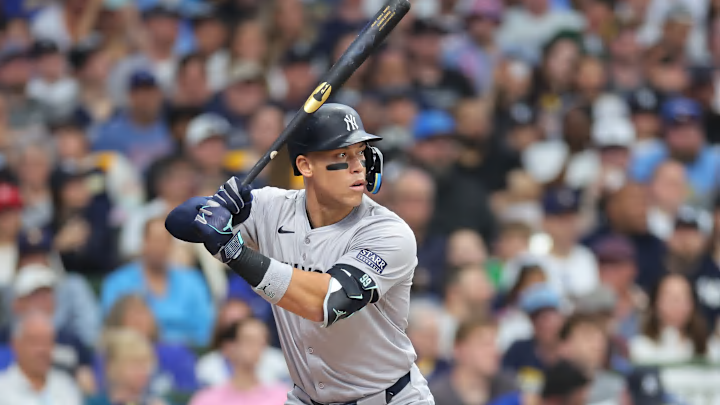An umpire controversy in Milwaukee. In the 6th inning of Sunday's game against the Yankees, the Brewers had just tied up the game at four on a Jake Bauers home run and were turning the game over to the bullpen.
Abner Uribe came in for the 6th, gave up a walk to Aaron Judge, then induced a perfect 4-6-3 double play ball from Alex Verdugo. As Adames was completing the turn however, the 6-foot-8 inch Judge threw up his left hand to block Adames' throw to first. The ball hit him in the hand, thus allowing Verdugo to reach.
Immediately, the Brewers called for runner's interference and Pat Murphy went out to argue with the umpires that interference should be called and Verdugo should be out at first. The entire four man umpiring crew of Mike Muchlinski, Jansen Visconti, Derek Thomas, and Andy Fletcher got together and discussed. After a short discussion, the umpires ruled no interference on Judge, and Verdugo was allowed to stay on first.
This was *not* called interference on Aaron Judge. pic.twitter.com/NCFGKCzq7l
— Hunter Baumgardt (@hunterbonair) April 28, 2024
Next up was a shallow infield pop by Giancarlo Stanton. Had interference been called the play before, would've been the third out of the inning and it would've been a clean 6th for Uribe. Instead, that was just the second out.
What followed was a series of unfortunate events that culminated in a seven run rally by the Yankees, all with two outs. A walk to Anthony Rizzo, a single by Gleyber Torres, a walk to Oswaldo Cabrera, a single by Jose Trevino, a walk to Anthony Volpe, a Juan Soto single, and a Judge single. The Yankees sent 11 men to the plate in the inning and led 11-4 at the end of the half inning once Verdugo finally grounded out to end it.
What is the actual runner's interference rule?
Here's what the rulebook has to say about runner's interference.
"(6) If, in the judgment of the umpire, a base runner willfully and deliberately interferes with a batted ball or a fielder in the act of fielding a batted ball with the obvious intent to break up a double play, the ball is dead. The umpire shall call the runner out for interference and also call out the batter-runner because of the action of his teammate. In no event may bases be run or runs scored because of such action by a runner (see Rule 6.01(j));"
It seems quite clear based on the video that Judge willfully and deliberately threw his hand up with the obvious intent to break up the potential double play. By rule, the ball is dead and both the runner and batter are called out because of the action of the teammate.
Yet, the umpires did not call interference on this play and Verdugo was allowed to stay on first base instead of being out. It would appear that the umpires got the call incorrect on the field.
The crew chief, Andy Fletcher, actually admitted as much to a pool reporter after the game.
"Can you explain why it was ruled Judge did not interfere with the throw from Adames?
On the field, we got together and did the best that we could to come up with the correct answer. After looking at it off the field in replay, it appears that the call was missed. It should’ve been called interference because it wasn’t a natural part of his slide. It didn’t appear that way to us. We did everything we could to get together and get it right. But after looking at it, it appears that it should’ve been called interference.
Could you explain why it wasn’t a natural part of the slide?
Just didn’t appear to be after looking at it.
And that play is not reviewable, correct?
It is not reviewable."
This play is not able to be challenged by Pat Murphy, which is why the ruling was allowed to stand despite it being incorrect.
The Brewers were right in this game, and then things spiraled after that controversial no-call in the 6th. Very quickly, the Yankees put the game out of reach for the Crew.
